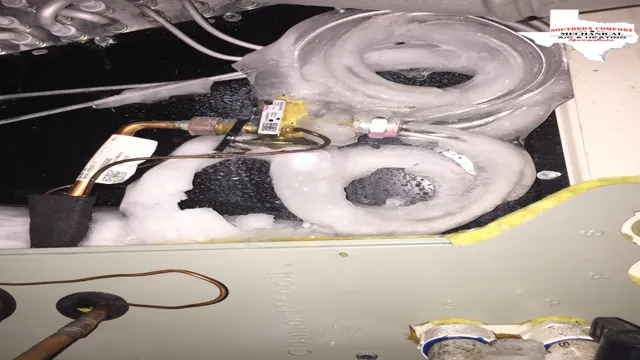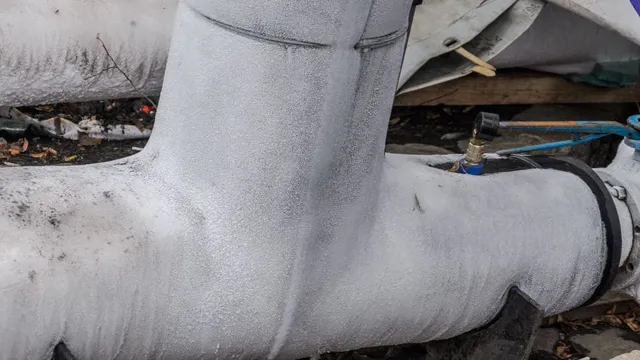When the summer heat hits, we all rely on our trusty air conditioning units to keep our homes cool and comfortable. So, it can be quite frustrating when you step outside and notice that your AC unit is no longer functioning as it should. One common issue that homeowners face is a frozen AC pipe outside.
This can lead to reduced airflow and a lack of cooling in your home. But don’t panic, as there are a few things you can do to fix the issue and get your AC unit back in working order. In this blog post, we’ll cover some effective tips and tricks on how to fix a frozen AC pipe outside so that you can beat the heat and enjoy a comfortable indoor environment once again.
Symptoms of a Frozen AC Pipe Outside
If you are experiencing warm air blowing from your air conditioner, it could be a sign of a frozen AC pipe outside. This happens when the coil inside the air conditioner gets too cold and freezes, causing the pipe to become blocked. Other signs of a frozen AC pipe outside include reduced airflow, water leakage, and strange noises coming from the unit.
You may even notice that your electricity bills are higher than usual. It’s essential to fix this issue as soon as possible, as a frozen AC pipe can cause serious damage to your unit and lead to costly repairs. To prevent this from happening, make sure to change your air filters regularly, keep the area around your AC unit clear, and schedule annual maintenance for your air conditioner.
In the meantime, turn off your unit and call a professional to come and assess the situation. With their help, you can quickly resolve the problem and have your cooling system back up and running smoothly.
Reduced Airflow
Reduced Airflow When it comes to keeping your home cool, a frozen AC pipe outside can be a real nuisance. One of the main symptoms of a frozen pipe is reduced airflow. You might notice that the air coming out of your vents is weaker than usual or that it takes longer for your home to cool down.
This is because the ice buildup on the pipe is preventing the air from flowing as freely as it should. If you suspect that you have a frozen pipe outside, it’s important to take action as soon as possible. Leaving it untreated can lead to further damage to your AC unit and potentially costly repairs down the line.

Warm Air Coming from Vents
Are you experiencing warm air coming from your vents even when your AC is supposed to be on? One possible cause of this issue is a frozen AC pipe outside. This can happen when there is a blockage or restriction in the flow of refrigerant, causing the coils to become too cold and freeze over. Symptoms of a frozen AC pipe outside include reduced airflow, icy buildup on the outdoor unit, and increased energy bills.
If you suspect that your AC pipe is frozen, it’s best to turn off your unit and contact a professional technician to inspect and repair the issue. Delaying repairs could lead to further damage and costly repairs down the line. Stay cool and comfortable by staying on top of your AC maintenance.
Causes of a Frozen AC Pipe Outside
AC frozen pipe outside is a common issue that most homeowners face during the hot summer months. The main reason behind a frozen AC pipe outside is poor air circulation, which results in a buildup of ice on the evaporator coil. This often happens when the air filter is clogged or dirty, causing restricted airflow and disrupting the overall functioning of the AC.
Moreover, low refrigerant levels may also be the root cause of a frozen AC pipe outside as it leads to a decrease in pressure inside the AC, which results in a drop in temperature below freezing point. To prevent this issue, it is essential to regularly clean or replace the air filter and ensure the refrigerant levels are sufficient. Additionally, it’s best to seek professional help to fix the issue if it persists as it could indicate more significant problems with the AC system.
Low Refrigerant Levels
If you notice a frozen AC pipe outside, the culprit could be low refrigerant levels in your air conditioning system. This happens when the refrigerant levels in your AC unit drop, causing the evaporator coil to get too cold and freeze the condensation on the pipes. A low refrigerant level can be caused by a leak in the AC system, which may require a professional repair.
Additionally, running your AC unit excessively without proper maintenance can also lead to low refrigerant levels, causing your AC pipes to freeze. To prevent this issue, it’s crucial to have your air conditioning system checked regularly by a certified technician and to schedule routine maintenance to ensure your unit operates efficiently all year round. Don’t let low refrigerant levels freeze your AC pipes and cause a headache; stay ahead of the game, and keep your AC system working its best!
Clogged Air Filter
When your air conditioning system experiences a clogged air filter, your AC pipe outside can freeze. The air filter is responsible for cleaning the air that enters the unit, and over time it can become blocked with dust and debris. A clogged air filter not only reduces the efficiency of your AC system but can also cause ice buildup on the coils.
As a result, the coil temperature drops below freezing point and causes the moisture in the air to freeze on the pipes. This can lead to a frozen AC pipe, which could cause a major problem if left untreated. To avoid this issue, it’s essential to change or clean the air filter regularly and ensure that your AC system is well-maintained.
A well-maintained system can operate efficiently, prevent ice buildup, and keep your home cool during the hot summer months. So, if you notice a frozen AC pipe, it’s time to call in a professional HVAC technician to solve the issue.
Malfunctioning Thermostat
If your air conditioning (AC) system’s pipe has frozen outside, it could be due to a malfunctioning thermostat. The thermostat is responsible for regulating the temperature of your AC unit and ensuring it doesn’t get too cold. If the thermostat becomes faulty, it can cause the AC unit to continue running beyond the temperature set by the thermostat, leading to a frozen pipe outside.
Additionally, another common cause of a frozen pipe outside is a clogged air filter. A dirty or clogged air filter hinders the airflow, causing the evaporator coil to freeze and eventually leading to a frozen pipe outside. To prevent these problems, ensure that you replace your air filters regularly and schedule regular maintenance checks for your AC system.
By doing so, you will avoid costly repairs and even potential health risks associated with poor indoor air quality.
Preventing a Frozen AC Pipe Outside
When temperatures drop, the last thing you want is a frozen AC pipe outside. Not only can it prevent your AC system from properly cooling your home, but it can also cause significant damage to your system. Luckily, preventing a frozen AC pipe outside is relatively simple.
One way is to ensure proper airflow around your AC unit by keeping the area around the unit clear of debris and foliage. It’s also important to regularly check and change your air filters to prevent blockages that can restrict airflow. Another helpful tip is to consider installing insulation around the exterior pipe to prevent freezing in cold weather.
And if you do notice that your AC pipe has frozen, turn off the system and allow it to thaw naturally to prevent bursting. A little preventive maintenance can go a long way to keep your AC system running smoothly throughout the year.
Regular Maintenance
When it comes to regular maintenance for your air conditioning system, it’s important not to overlook preventative measures. One common issue that homeowners face is a frozen AC pipe outside. This happens when the temperature drops and moisture accumulates on the outside of the unit, causing ice to form on the pipes.
Not only is this a nuisance, but it can also cause damage to your AC unit and reduce its efficiency. To prevent a frozen AC pipe outside, it’s crucial to ensure that your unit is properly insulated and free of debris. Additionally, it’s a good idea to have a professional conduct a thorough inspection of your system on an annual basis to catch any potential issues before they turn into major problems.
By taking these simple steps, you can keep your AC system running smoothly year-round and avoid the hassle of a frozen AC pipe.
Insulating the Pipe
If you’re experiencing issues with a frozen AC pipe outside, insulating it is a crucial step in preventing it from happening again. Insulating the pipe essentially means adding an extra layer of protection to it, allowing it to retain heat and resist freezing temperatures. One of the easiest methods of insulation is to use a foam sleeve, which can be easily purchased from any hardware store.
The foam sleeve is simply wrapped around the pipe and secured in place with zip ties. In addition to foam sleeves, electrical heating tape can also be installed along the length of the pipe. This tape automatically turns on when temperatures drop, helping to keep the pipe above freezing levels.
Proper insulation is essential for preventing expensive damage to your AC system. By taking the necessary steps to insulate the pipe, you can enjoy cool and comfortable temperatures in your home without the stress and expense of a damaged AC unit.
Fixing a Frozen AC Pipe Outside
If you notice that your AC pipe outside is frozen, you’ll want to take care of it right away to avoid any damage to the equipment. One common cause of a frozen AC pipe outside is low refrigerant levels, which can be fixed with the help of a professional technician. Other causes could be dirty air filters or restricted airflow, so it’s important to replace filters regularly and make sure there’s nothing blocking the unit’s vents.
One simple method to thaw a frozen pipe outside is to turn off the AC unit and turn on the fan to help melt the ice. You can also try using warm water or a hair dryer to gently thaw the pipe, but be careful not to damage the unit or electrocute yourself. If you suspect that there may be a more serious issue, it’s always best to call a professional for help.
Don’t let a frozen AC pipe outside go unchecked – taking care of it quickly can save you from bigger problems down the road.
Thawing the Pipe
One of the most dreaded scenarios for homeowners during the sweltering summer months is a frozen AC pipe outside. This issue can occur due to a combination of low outdoor temperatures and blockages in the system that prevent proper air flow. To tackle this problem, the first step is to turn off the AC unit and let the pipe thaw naturally.
Attempting to force a thaw with hot water or other methods could cause serious damage and end up costing you more in the long run. Once the pipe is thawed, you can investigate and remove any blockages, such as dirt or debris, from the outdoor unit. It’s also a good idea to ensure proper insulation for the pipes to prevent future freeze-ups.
By taking these steps, you can fix a frozen AC pipe outside and keep your home comfortably cool during even the hottest summer days.
Checking for Damage
If you have noticed that your air conditioning system is not working as well as it should be, it may be a sign of a frozen AC pipe outside. This is a common issue during the summer months and can cause the system to stop working altogether. The first step is to check the pipe for damage, as any cracks or leaks can worsen the situation.
If there are no visible signs of damage, the next step is to turn off the system and let it thaw out. Once the system has thawed, you can turn it back on and check for any more issues. A frozen AC pipe can be frustrating, but with a little bit of effort, you can fix the problem and enjoy cool air again.
Don’t let a frozen pipe ruin your summer, take the time to check for damage and thaw out your system if necessary.
Repairing or Replacing the Pipe
If your AC pipe outside is frozen, you may be wondering what your options are. One potential solution is repairing or replacing the pipe. If your pipe has burst, replacement is the only option.
However, if the pipe is just frozen, you can attempt to thaw it out and see if any damage has been done. If the pipe looks okay but you’re still not getting cool air, it’s possible that the system is low on refrigerant, in which case a professional will need to come and recharge it. It’s important to address the issue as soon as possible, as a frozen pipe and low refrigerant levels can both cause damage to your AC unit.
Don’t hesitate to call a professional if you’re not sure what steps to take.
Conclusion
In the world of frozen pipes, there is no greater foe than the dreaded outdoor pipe. It sits outside, exposed to the harsh elements, primed and ready to burst at a moment’s notice. But fear not, dear reader.
With the right precautions and maintenance, even the most stubborn outdoor pipe can be tamed. So next time a cold snap comes knocking, grab your trusty pipe insulation and show that pipe who’s boss. After all, there’s nothing cooler than a hot shower on a frosty morning.
“
FAQs
How can I prevent my outside pipes from freezing?
The best way to prevent outside pipes from freezing is to insulate them properly and to disconnect any outdoor hoses. It’s also important to allow a slow and steady drip of water from your faucets in extreme cold weather.
What do I do if my outside pipes have already frozen?
First, turn off the water supply to the affected area to prevent any further damage. Then, use a hairdryer or heat lamp to carefully thaw the pipe. Do not use an open flame or other high-heat source.
How can I tell if my outside pipes are frozen?
If you turn on the faucet and little to no water comes out, your pipes may be frozen. Other signs include bulging in the pipe, a strange smell coming from the faucet, and frost on the outside of the pipe.
Is it necessary to hire a professional to fix a frozen outdoor pipe?
Depending on the severity of the damage, it may be necessary to hire a professional plumber. However, if you catch the issue early and have some DIY skills, you may be able to thaw the pipe and fix any damage yourself.

